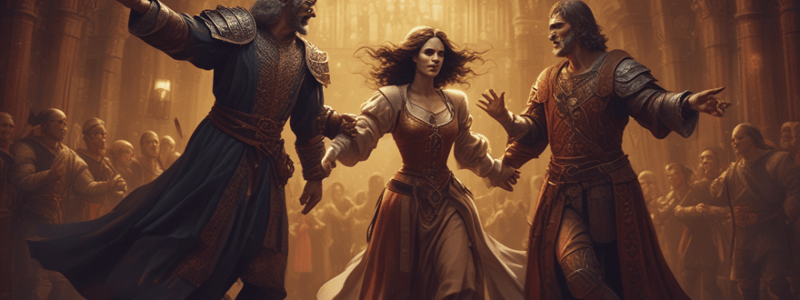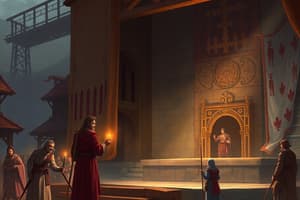Podcast
Questions and Answers
What was the primary purpose of physicality and gesture in medieval acting?
What was the primary purpose of physicality and gesture in medieval acting?
- To develop complex characters
- To engage the audience emotionally
- To communicate the message of the play to illiterate audiences (correct)
- To portray characters accurately
Why was vocal projection important in medieval acting?
Why was vocal projection important in medieval acting?
- To be heard by the audience in the absence of microphones (correct)
- To add dramatic effect to the performance
- To engage the audience emotionally
- To develop complex characters
What was the primary function of masks in medieval acting?
What was the primary function of masks in medieval acting?
- To enhance the actor's vocal projection
- To conceal the actor's identity
- To exaggerate gestures and movements
- To transform into various characters (correct)
Why did medieval actors rely on nonverbal communication?
Why did medieval actors rely on nonverbal communication?
What was the role of minstrels or trouvères in medieval theatrical performances?
What was the role of minstrels or trouvères in medieval theatrical performances?
What was the significance of exaggerated gestures in medieval acting?
What was the significance of exaggerated gestures in medieval acting?
What was the primary characteristic of medieval acting?
What was the primary characteristic of medieval acting?
What was the context in which medieval theatrical performances often took place?
What was the context in which medieval theatrical performances often took place?
What is the main purpose of masks in Commedia dell'arte?
What is the main purpose of masks in Commedia dell'arte?
What is a distinctive feature of costumes in Commedia dell'arte?
What is a distinctive feature of costumes in Commedia dell'arte?
Where were Commedia dell'arte performances typically held?
Where were Commedia dell'arte performances typically held?
What is a key characteristic of Commedia dell'arte performances?
What is a key characteristic of Commedia dell'arte performances?
What is a significant influence of Commedia dell'arte on modern theater?
What is a significant influence of Commedia dell'arte on modern theater?
What is a common adaptation of Commedia dell'arte's stock characters?
What is a common adaptation of Commedia dell'arte's stock characters?
When did Commedia dell'arte originate?
When did Commedia dell'arte originate?
What is a notable feature of Commedia dell'arte's performance style?
What is a notable feature of Commedia dell'arte's performance style?
Why did medieval actors need to master nonverbal communication?
Why did medieval actors need to master nonverbal communication?
What was a key aspect of Renaissance acting styles?
What was a key aspect of Renaissance acting styles?
What technique was used to understand and portray complex emotions in Renaissance acting?
What technique was used to understand and portray complex emotions in Renaissance acting?
What technique did medieval actors use to bring authenticity to their performances?
What technique did medieval actors use to bring authenticity to their performances?
What was a characteristic of interactions between Renaissance actors and the audience?
What was a characteristic of interactions between Renaissance actors and the audience?
What was the primary purpose of direct address in medieval plays?
What was the primary purpose of direct address in medieval plays?
What was the influence of Renaissance acting styles on modern acting techniques?
What was the influence of Renaissance acting styles on modern acting techniques?
What was the focus of Renaissance acting?
What was the focus of Renaissance acting?
What was the origin of Commedia dell'arte?
What was the origin of Commedia dell'arte?
What was the significance of the Renaissance period in the development of acting techniques?
What was the significance of the Renaissance period in the development of acting techniques?
What is a characteristic of Pantalone in Commedia dell'arte?
What is a characteristic of Pantalone in Commedia dell'arte?
What was the primary goal of Renaissance actors' use of gestures and movement?
What was the primary goal of Renaissance actors' use of gestures and movement?
What was the significance of voice training in Renaissance acting?
What was the significance of voice training in Renaissance acting?
What is the term for the comic routines and gags in Commedia dell'arte?
What is the term for the comic routines and gags in Commedia dell'arte?
What was the primary difference between medieval and Renaissance acting styles?
What was the primary difference between medieval and Renaissance acting styles?
What was a key feature of Commedia dell'arte performances?
What was a key feature of Commedia dell'arte performances?
What was the role of Brighella in Commedia dell'arte?
What was the role of Brighella in Commedia dell'arte?
What was the significance of the rise of the printing press in the Renaissance period?
What was the significance of the rise of the printing press in the Renaissance period?
What is the significance of studying Renaissance acting styles?
What is the significance of studying Renaissance acting styles?
What was the primary purpose of researching specific plays and actors from the medieval period?
What was the primary purpose of researching specific plays and actors from the medieval period?
Flashcards
Medieval Acting
Medieval Acting
Medieval acting relied on exaggerated physicality, gestures, and vocal projection to portray characters.
Masking (Medieval)
Masking (Medieval)
Actors wore masks to transform into characters and make them recognizable.
Nonverbal Communication (Medieval)
Nonverbal Communication (Medieval)
Actors used body language, facial expressions, and actions to portray emotions and character intentions.
Emotional Memory (Medieval)
Emotional Memory (Medieval)
Signup and view all the flashcards
Direct Address (Medieval)
Direct Address (Medieval)
Signup and view all the flashcards
Physical Comedy (Medieval)
Physical Comedy (Medieval)
Signup and view all the flashcards
Renaissance Acting (general)
Renaissance Acting (general)
Signup and view all the flashcards
Renaissance Playhouses
Renaissance Playhouses
Signup and view all the flashcards
Renaissance Voice Training
Renaissance Voice Training
Signup and view all the flashcards
Renaissance Emotional Journeys
Renaissance Emotional Journeys
Signup and view all the flashcards
Renaissance Improvisation
Renaissance Improvisation
Signup and view all the flashcards
Commedia dell'arte (general)
Commedia dell'arte (general)
Signup and view all the flashcards
Stock Characters (Commedia)
Stock Characters (Commedia)
Signup and view all the flashcards
Lazzi (Commedia)
Lazzi (Commedia)
Signup and view all the flashcards
Masks (Commedia)
Masks (Commedia)
Signup and view all the flashcards
Costumes (Commedia)
Costumes (Commedia)
Signup and view all the flashcards
Improvisation (Commedia)
Improvisation (Commedia)
Signup and view all the flashcards
Study Notes
Medieval Acting Techniques
- During the Middle Ages, actors used physicality and exaggerated gestures to convey emotions and portray characters.
- They relied on vocal projection to ensure their voices were heard by the audience.
- Masking was a popular technique, allowing actors to transform into various characters and make them more identifiable to the audience.
- Nonverbal communication, such as actions, facial expressions, and body language, was used to express emotions and convey character intentions.
- Actors employed emotional memory, drawing upon personal emotions and experiences to bring authenticity to their performances.
- Direct address was used, where actors spoke directly to the audience, engaging them and creating a sense of participation.
- Physical comedy, including slapstick humor and exaggerated movements, was used to entertain the audience.
Renaissance Acting Techniques
- During the Renaissance, acting styles evolved, focusing on naturalism and realism.
- Theaters transformed from church settings to purpose-built playhouses, and professional actors emerged.
- Actors emphasized classical rhetoric and gestures to enhance their performances.
- Voice training was essential, with a focus on correct pronunciation, enunciation, and rhetorical devices.
- Actors explored characters' emotional journeys, using techniques like humorism to understand and portray complex emotions.
- Improvisation was common, enabling actors to react and adapt to unexpected situations on stage.
Commedia dell'arte
- Commedia dell'arte emerged in 16th-century Italy as a form of improvisational theater.
- It is characterized by masked stock characters, physical comedy, and improvisation based on a pre-determined plot outline.
- Stock characters include Pantalone, Arlecchino, Brighella, Columbina, and Il Dottore, each with distinct masks, costumes, and personality traits.
- Improvisation and lazzi (comic routines and gags) are essential features of Commedia dell'arte.
- Masks and costumes are crucial, amplifying characters' personalities and making them recognizable to the audience.
- Commedia dell'arte had a significant influence on modern theater and comedy, with its emphasis on improvisation and physical comedy.
Studying That Suits You
Use AI to generate personalized quizzes and flashcards to suit your learning preferences.




